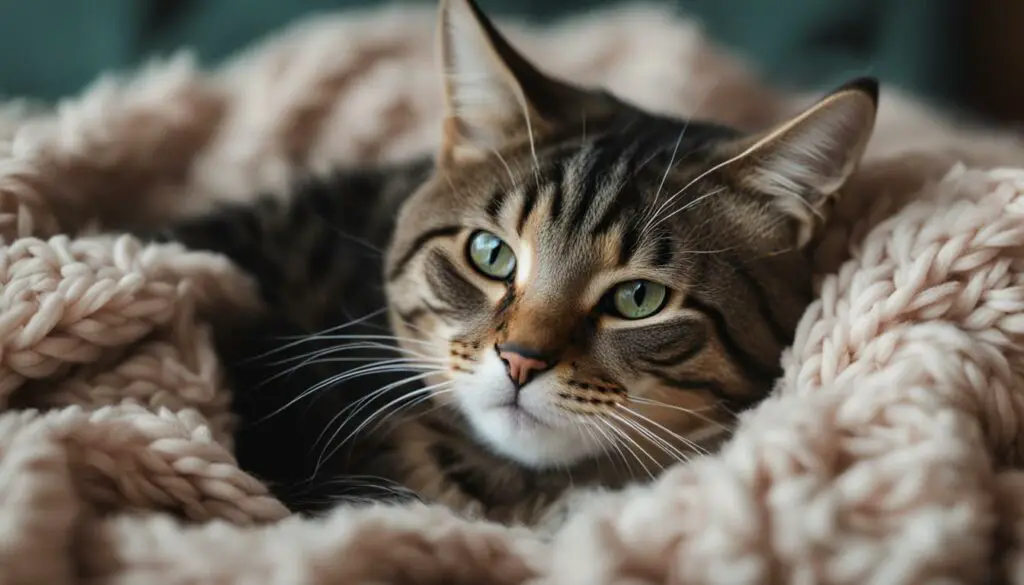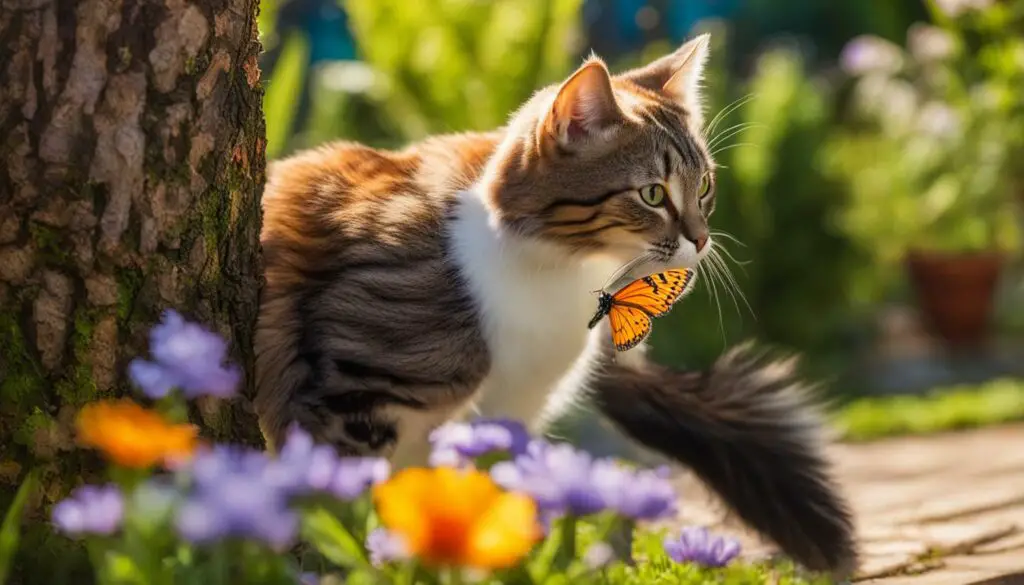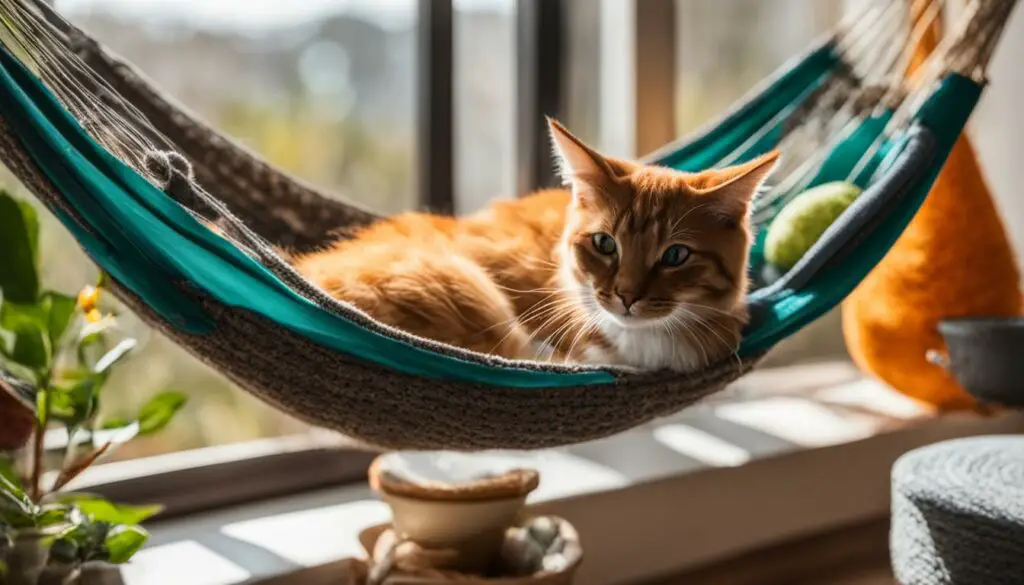As a cat owner, you may have wondered why female cats sometimes disappear when they’re in heat. It turns out that these furry felines are driven by their strong reproductive instincts, which can lead them to run away in search of a male cat to mate with. Let’s delve into the fascinating world of female cat behavior during their heat cycles and uncover some curious facts!
Key Takeaways:
- Female cats may run away when in heat due to their strong reproductive instincts.
- Spaying your female cat can help reduce the likelihood of them running away.
- Mating, territory, hunting instinct, and curiosity are factors that can contribute to a female cat’s desire to roam.
- Stress, neglect, fear, and sickness can also drive female cats to run away from home.
- Responsible pet ownership, such as spaying and providing a safe environment, can help prevent cats from running away.
The Reproductive Instinct in Female Cats
Female cats have a strong reproductive instinct, particularly when they are in heat. This instinct drives them to find suitable mating partners and may result in them roaming outside of their territory. The desire to reproduce can be so strong that female cats may run away from home in pursuit of mating opportunities. This behavior is a natural response to their biological urge to procreate.
During the heat cycle, female cats release pheromones that attract male cats. These pheromones serve as signals to potential mates that the female cat is ready to reproduce. As a result, female cats may exhibit restlessness, vocalization, and increased affectionate behavior towards their owners. However, if they do not find a suitable mate, their instinctual drive may lead them to explore unfamiliar territories in search of potential partners.
To prevent female cats from running away when in heat, spaying is highly recommended. Spaying involves the surgical removal of a cat’s reproductive organs, eliminating their desire to mate and roam. Spaying not only helps prevent unwanted pregnancies but also reduces the risk of reproductive health issues, such as uterine infections and certain types of cancer. By spaying female cats, owners can ensure their pets’ well-being and help control the cat population.

The Reproductive Instinct in Female Cats
The reproductive instinct in female cats is a powerful force that drives them to find mating partners and search for potential mates. This instinct can lead them to roam outside of their territory in search of suitable partners. By understanding this instinct and taking necessary measures, such as spaying, owners can ensure their female cats’ safety and prevent them from running away.
The Hunting Instinct and Territory in Female Cats
Female cats possess a natural hunting instinct, which drives them to explore their surroundings and expand their territory (SEO: female cats, hunting instinct, territory, exploring, expansion). This instinct can lead them to run away from home in search of new hunting grounds and to claim other areas as their own. However, it’s important to note that the larger their territory becomes, the higher the chances they will encounter other cats and potential dangers. This puts them at risk of fights, injuries, and exposure to diseases.
In many ways, female cats are not so different from their wild counterparts. They have a strong instinct to hunt, which has been ingrained in them through thousands of years of evolution. This drive to chase and catch prey is an essential part of their nature that can cause them to venture far from home (SEO: female cats, hunting instinct, territory). As they explore, they mark their territory with scent markings and establish their presence in new areas. This behavior is not only a means of survival but also a way for them to assert their dominance and secure their resources.
It’s worth noting that while some female cats may run away in search of new territories, others do so purely out of curiosity. Cats are naturally curious creatures (SEO: female cats, hunting instinct, territory, exploring). They are driven by a desire to explore their environment and discover new things. This curiosity can lead them to roam further from home, as they are enticed by unfamiliar sights, sounds, and smells. However, it’s important for owners to be aware of the potential risks associated with their cat’s curiosity and take measures to ensure their safety.
| Hunting Instinct and Territory in Female Cats | |
|---|---|
| Female Cats | Have a strong hunting instinct. |
| Tend to explore and expand their territory. | |
| May run away from home to hunt and claim new areas. | |
| Curiosity | Female cats are naturally curious. |
| Curiosity can lead them to roam further from home. | |
| Cat owners should ensure their safety. |
Understanding the hunting instinct and territory behaviors in female cats can help pet owners better comprehend why their cats may choose to run away (SEO: female cats, hunting instinct, territory). By providing a stimulating environment with plenty of enrichment activities, such as interactive toys and scratching posts, owners can satisfy their cat’s natural instincts and reduce the desire to roam. Additionally, creating a safe and secure outdoor space or using harnesses and leashes can allow cats to explore and expand their territory while minimizing the risks associated with running away from home. Ultimately, it’s crucial for pet owners to balance their cat’s natural instincts with their safety and well-being.
Cheating and Pregnant Cats
When it comes to female cats running away, there are a few interesting factors to consider. Some female cats may run away from home because they have found a secondary home where they receive extra attention, food, or treats. These cats may enter other people’s houses regularly or be fed by neighbors, leading to their absence from their original home. This behavior can be seen as “cheating,” as they seek out additional resources and affection outside of their primary residence.
In addition, when a female cat is pregnant, she may exhibit behaviors that drive her to run away from home. This instinctual behavior is driven by the need to find a secluded and safe location to give birth and raise her kittens. The desire to protect her offspring pushes the pregnant cat to hide and potentially run away in search of a suitable place. This natural instinct can sometimes cause temporary separation between the cat and her primary home.
It’s important for cat owners to be aware of these behaviors and take necessary steps to prevent them from running away. Providing a secure and enriching environment, ensuring proper identification with collars or microchips, and providing regular veterinary care can help reduce the likelihood of a female cat running away due to cheating or pregnancy.

Table: Reasons for Female Cats Running Away
| Reasons | Description |
|---|---|
| Cheating | Seeking attention and resources in secondary homes |
| Pregnancy | Running away in search of a safe place to give birth and raise kittens |
| Multiple Homes | Exploring and staying in different households |
| Hiding | Seeking seclusion and privacy |
Stress and Neglect as Reasons for Running Away
Stress and neglect can be significant factors that drive female cats to run away from home. Cats, like humans, are sensitive creatures who can experience various forms of stress. Changes in the household, such as the arrival of a new pet or family member, renovations, or loud noises, can cause stress and anxiety in cats. If a cat feels overwhelmed by these changes or neglected due to lack of attention or care, they may seek shelter, love, and attention elsewhere.
The home environment plays a crucial role in a cat’s well-being. Cats require a safe and enriching environment where they can feel comfortable and secure. Neglecting their physical and emotional needs can result in stress, causing them to seek solace outside of their familiar surroundings. Providing adequate food, water, shelter, and regular interaction is essential for maintaining a positive home environment and preventing cats from running away.
It is important for cat owners to recognize the signs of stress and take proactive steps to alleviate it. Creating a calm and peaceful environment, establishing a routine, and offering interactive toys and activities can help reduce stress levels. Additionally, seeking professional advice from a veterinarian or animal behaviorist can provide invaluable guidance on how to manage stress and ensure the well-being of your feline companion.
Recognizing Signs of Stress in Cats
- Excessive grooming or self-mutilation
- Loss of appetite or overeating
- Withdrawal or hiding
- Increase in aggression or destructive behavior
- Changes in litter box usage
- Vocalization or excessive meowing
By being attentive to their needs and providing a nurturing environment, cat owners can help reduce stress and minimize the risk of their female cats running away.
| Stress Factors | Preventive Measures |
|---|---|
| Household changes | Maintain a consistent routine and provide a safe space for your cat to retreat to |
| Lack of attention or interaction | Engage in regular playtime and provide mental stimulation through interactive toys |
| Neglecting physical and emotional needs | Ensure your cat has access to food, water, litter box, and a comfortable resting area |
| Loud noises or chaotic environments | Create a peaceful and quiet space for your cat, especially during times of increased noise |
By addressing stress and neglect, cat owners can create a loving and secure home environment that promotes the well-being of their female cats and reduces the likelihood of them running away.

Fear, Sickness, and Curiosity
Female cats may run away from home due to various reasons, including fear, sickness, and curiosity. Just like humans, cats can feel scared in certain situations, causing them to flee or hide nearby. When cats are sick, they may seek isolation and quiet places to recover, sometimes venturing far from home in search of solitude. Additionally, cats are naturally curious creatures, and their curiosity can lead them to explore their surroundings and get easily distracted, resulting in them running away for short periods of time.
It is essential to understand that fear, sickness, and curiosity are natural instincts for cats and can be difficult to control. However, there are measures that pet owners can take to minimize the risks associated with these instincts. Providing a safe and secure environment for cats both indoors and outdoors can help alleviate fear and reduce the likelihood of cats running away. Creating designated hiding spots or safe areas within the home can also give cats a sense of security during times of stress or sickness.
Fear
Fear can cause female cats to run away from home. They might feel threatened by loud noises, unfamiliar people, or other animals, leading them to flee or hide in nearby areas. It can be challenging for owners to locate their cats when they are scared and hiding, making it important to create a calm and comforting environment for them to return to. Offering treats, playing soothing music, or providing a cozy hiding spot can help alleviate fear and prevent cats from running away in response to perceived threats.
Sickness
When cats are sick, they may run away from home in search of solitude and a quiet place to rest and recover. It is crucial to monitor the health of female cats and seek veterinary care when needed. By addressing illnesses promptly and providing proper treatment, pet owners can prevent cats from feeling the need to run away in an attempt to find relief from their discomfort. Creating a comfortable and quiet space within the home where sick cats can rest undisturbed can also help alleviate the urge to seek isolation outside.
Curiosity
“Curiosity killed the cat.” – Proverb
Cats are naturally curious animals and have a strong instinct to explore their surroundings. This curiosity can sometimes lead them to wander away from home, especially if they encounter something intriguing or unfamiliar. To satisfy their curiosity while minimizing the risk of running away, pet owners can provide stimulating toys, scratching posts, and interactive play sessions to keep cats entertained and engaged within the home. Regularly introducing new smells, sounds, and objects can also help fulfill a cat’s curiosity without the need to venture outdoors.
Understanding these instinctual behaviors in female cats can help pet owners create a safe and nurturing environment that prevents them from running away. By addressing fear, sickness, and curiosity through proactive measures, such as providing secure hiding spots, monitoring health, and offering engaging stimuli, pet owners can ensure the well-being and safety of their female cats within the comfort of their homes.

Natural Predators and Disease
When female cats run away from home, they expose themselves to various risks in the outdoor environment. One significant danger they may encounter is natural predators. These predators, such as coyotes, foxes, and large birds, can pose a threat to the safety of female cats. Being smaller and more vulnerable, female cats may fall prey to these predators, leading to injury or even death.
Furthermore, the outdoor environment exposes female cats to a higher risk of contracting diseases compared to their indoor counterparts. Cats that roam freely can come into contact with viruses, bacteria, and parasites that can negatively impact their health. Infectious diseases, such as feline leukemia virus (FeLV) and feline immunodeficiency virus (FIV), can be transmitted through direct contact with infected cats or contaminated environments.
| Predators | Diseases |
|---|---|
| Coyotes | FeLV (Feline Leukemia Virus) |
| Foxes | FIV (Feline Immunodeficiency Virus) |
| Large Birds | Upper Respiratory Infections |
Female cats that run away from home can be at risk of encountering natural predators, such as coyotes, foxes, and large birds. Additionally, the outdoor environment exposes them to various diseases, including FeLV and FIV. It is crucial to consider these risks when allowing female cats to roam freely.
To ensure the safety and well-being of female cats, it is essential to provide them with a protected and controlled environment. Keeping cats indoors or providing them with supervised outdoor access through enclosed spaces, such as catios, can significantly reduce their exposure to predators and disease. Additionally, regular veterinary care, including vaccinations and parasite prevention, can help safeguard female cats against common health risks.
By understanding and addressing the dangers posed by natural predators and diseases, responsible pet owners can protect their female cats and promote their overall health and longevity. Ensuring a safe and secure environment for these feline companions is paramount in providing them with the best possible quality of life.

Section 8: Animal Control, Theft, and Intentional Loss
Female cats that run away from home can be vulnerable to various risks including encounters with animal control, theft, or intentional loss. It is important for cat owners to be aware of these potential dangers and take necessary precautions to ensure the safety of their feline companions.
Animal control agencies play a crucial role in ensuring the well-being of stray and lost animals. When a female cat is found roaming without identification, she may be picked up by animal control. To prevent this from happening, it is important to ensure that your cat has proper identification, such as a collar with tags or a microchip. This increases the chances of being reunited with your cat if she goes missing.
Unfortunately, theft of pets is a sad reality. Female cats can be particularly vulnerable due to their value for breeding purposes. It is important to keep a close eye on your cat and take steps to prevent theft. This may include keeping your cat indoors, especially during times of increased risk, such as holidays when pet theft is more prevalent.
Intentional loss of a cat can occur for various reasons, including abandonment or intentionally leaving the cat in a different location. This is a cruel and irresponsible act that can have serious consequences for the cat’s well-being. If you are unable to care for your cat, it is important to seek out responsible alternatives such as rehoming through a reputable organization or reaching out to local animal shelters for assistance.
Table: Comparing Risks for Female Cats
| Risk | Description |
|---|---|
| Animal Control | Cats found roaming without identification may be picked up by animal control. |
| Theft | Female cats can be targeted for theft due to their breeding potential. |
| Intentional Loss | Cats may be intentionally abandoned or left in a different location by their owners. |
Being aware of these risks and taking appropriate measures can help protect your female cat from running away or falling victim to theft or intentional loss. Remember, responsible pet ownership entails providing a safe and loving environment for your cat and taking steps to minimize potential risks and protect their well-being.

Finding Their Way Back Home
Female cats have a remarkable sense of direction and a strong instinct to find their way back home. Studies have shown that they tend to stay within a one-mile radius of their territory, relying on their keen senses and familiarity with their surroundings to navigate.
When a female cat goes missing, it is essential not to panic. Cats are resourceful creatures and often return on their own. However, there are steps you can take to help expedite their return. First, ensure that their home environment remains familiar and comforting. Leave out their favorite toys, bedding, and a bowl of food or treats to entice them back.
If your cat has not returned after a few days, consider the following strategies:
- Search the immediate area: Start by looking in nearby hiding spots such as bushes, sheds, or under porches. Call out your cat’s name and use familiar sounds to alert them to your presence.
- Inform neighbors: Reach out to your neighbors and inform them that your cat is missing. Provide them with a description and ask them to keep an eye out.
- Post flyers and check local shelters: Create posters with your cat’s photo and contact information. Hang them in the community and check local animal shelters regularly, as your cat may have been picked up by animal control.
Remember, patience is key when waiting for your female cat to find her way back home. By staying proactive and utilizing these strategies, you can increase the chances of a joyful reunion.
| Tip | Description |
|---|---|
| Leave out familiar scents | By placing familiar scents, such as your cat’s bedding or a worn piece of clothing, outside your home, you can help guide them back with their keen sense of smell. |
| Utilize social media | Spread the word about your missing cat on social media platforms and local community groups. This can help reach a wider audience and increase the chances of someone spotting and recognizing your cat. |
| Consider a professional pet tracker | If you’re still unable to locate your cat, you may want to enlist the help of a professional pet tracker. These individuals specialize in locating lost pets and can increase the chances of finding your feline friend. |
Preventing Cats from Running Away
Preventing female cats from running away requires proactive measures to address their natural instincts and needs. Spaying your female cat is highly recommended to decrease their reproductive drive and reduce the likelihood of them roaming in search of mates. This surgical procedure not only helps prevent unwanted litters but also contributes to controlling the cat population, promoting responsible pet ownership, and minimizing the strain on animal shelters.
Creating an enriching environment for your female cat can also deter her from running away. Providing plenty of entertainment, such as interactive toys and scratching posts, helps keep cats mentally stimulated and content at home. Regular playtime and affectionate interaction with your cat can strengthen the bond between you and provide her with the attention she craves.
Ensuring a safe and secure environment both indoors and outdoors is crucial in preventing cats from running away. Make sure your home has secure windows and doors to prevent accidental escapes. If you allow your cat outdoors, consider providing a safely enclosed outdoor space or using a harness and leash for supervised outdoor excursions. Additionally, consider microchipping your cat and ensuring she wears a collar with identification tags, which can increase the chances of a safe return if she does manage to run away.
Table: Tips for Preventing Cats from Running Away

| Prevention Strategies | Description |
|---|---|
| Spaying | Reduce reproductive instincts and roaming behavior |
| Enrichment | Provide interactive toys and scratching posts |
| Playtime and Affection | Engage in regular play sessions and give attention to your cat |
| Secure Environment | Ensure windows and doors are secure to prevent escapes |
| Outdoor Safety | Consider enclosed outdoor spaces or supervised outings |
| Identification | Microchip your cat and use collar tags for easy identification |
By implementing these preventive measures, you can help ensure the safety and well-being of your female cat, preventing her from running away and facing potential risks and challenges in the outdoor world.
The Importance of Responsible Pet Ownership
Responsible pet ownership plays a vital role in ensuring the well-being of our feline companions and managing the cat population. One of the most significant steps pet owners can take is spaying and neutering their cats. This simple procedure not only prevents unwanted litters but also helps control the cat population by reducing the number of stray and feral cats.
By spaying female cats, we can eliminate their desire to roam in search of mates during heat cycles. Neutering male cats also reduces their instinct to roam and engage in territorial and mating behaviors. These procedures not only benefit individual cats but also have a broader impact on the overall welfare of feline communities.
| Benefits of Responsible Pet Ownership | Actions |
|---|---|
| Preventing overpopulation | Spaying and neutering cats |
| Reducing roaming behavior | Providing a safe and enriching environment |
| Ensuring cat welfare | Providing proper care, nutrition, and veterinary attention |
| Promoting responsible pet ownership | Educating others and raising awareness |
In addition to spaying and neutering, responsible pet ownership involves providing a safe and stimulating environment for cats. This includes ensuring they have access to appropriate toys, scratching posts, and environmental enrichment. Regular veterinary care, proper nutrition, and attention to their emotional well-being are also essential elements of responsible ownership.
By embracing responsible pet ownership practices, we can contribute to the welfare of our beloved feline friends, prevent the challenges associated with cat overpopulation, and create healthier and happier communities for both cats and humans alike.
The Impact on Cat Welfare and Animal Shelters
When cats run away or are abandoned, it can have a significant impact on their welfare and contribute to the growing population of stray and outdoor cats. This, in turn, places a strain on animal shelters and rescue organizations, as they become overwhelmed with the influx of cats in need of care and rehoming. The welfare of these cats is at risk, as they may face hunger, illness, and danger without the support and protection of a loving home.
Stray cats, those that are born and raised in the outdoors, face a particularly challenging existence. They must scavenge for food, find shelter in harsh weather conditions, and navigate through dangerous environments. Without proper veterinary care, they are more susceptible to diseases, parasites, and injuries. Stray cats also have a shorter life expectancy compared to their indoor counterparts.
Animal shelters play a crucial role in providing assistance to stray and abandoned cats. However, limited resources, space, and funding make it difficult for shelters to accommodate the increasing number of cats in need. This often leads to overcrowding, stress, and the potential need for euthanasia due to lack of space and resources. It is a heartbreaking reality that could be alleviated with responsible pet ownership and proactive measures.
| Indoor Cats | Outdoor Cats |
|---|---|
|
|
By promoting responsible pet ownership and encouraging cat owners to keep their feline companions indoors, we can help reduce the number of stray and outdoor cats. Spaying and neutering cats also play a vital role in controlling the population and preventing unwanted litters. Supporting local animal shelters through donations, volunteering, or adopting a cat in need can make a significant difference in improving cat welfare and reducing the strain on shelters.
Remember, each cat deserves a loving and safe home. Let’s work together to protect their well-being and ensure a brighter future for all cats.

Conclusion
In conclusion, female cats may run away when they are in heat due to their strong reproductive instincts. However, there are several preventive measures that pet owners can take to minimize this behavior and ensure their cats’ safety and well-being.
The most effective way to prevent female cats from running away is through spaying. Spaying significantly reduces their desire to roam and seek mates, eliminating the risk of unwanted litters and contributing to responsible pet ownership.
Creating a stimulating and safe environment for female cats is also crucial in preventing them from running away. Providing plenty of entertainment, such as toys and scratching posts, can help keep them engaged and content at home. Ensuring a secure indoor and outdoor environment minimizes the risks associated with running away.
By practicing responsible pet ownership, including spaying, providing a stimulating environment, and promoting cat welfare, we can all play a part in preventing female cats from running away and ensuring their happiness and safety.
FAQ
Do female cats run away when in heat?
Yes, female cats may run away when they are in heat due to their strong reproductive instincts. They are driven to find a male cat to mate with, and this can lead them to roam outside of their territory.
Why do female cats run away when in heat?
Female cats are driven to find a male cat to mate with and may roam outside of their territory in search of potential partners. This instinct can lead them to run away from home in pursuit of mating opportunities.
Can spaying prevent female cats from running away?
Yes, spaying your female cat can help reduce their mating drive and prevent them from running away when they are in heat.
What other reasons may cause female cats to run away?
Besides being in heat, female cats may also run away due to their hunting instinct, seeking secondary homes, being pregnant and looking for a safe place to give birth, feeling stressed or neglected, being scared or curious, encountering natural predators, feeling sick, or being intentionally lost or stolen.
Can cats find their way back home after running away?
Cats have a strong sense of direction and can often find their way back home. However, the time it takes for a cat to return can vary, and some may take days or even weeks to find their way back.
How can I prevent my female cat from running away?
Spaying your female cat is highly recommended to reduce their desire to roam. Providing a stimulating and safe environment, practicing responsible pet ownership, and promoting cat welfare can also help prevent them from running away.
What is the importance of responsible pet ownership?
Responsible pet ownership, including spaying and neutering, helps control the cat population, reduce the number of stray and feral cats, and ensure the well-being of feline companions.
How does cat running away impact cat welfare and animal shelters?
When cats run away or are abandoned, it can contribute to the growing population of stray and outdoor cats. Animal shelters often become overwhelmed with stray cats, leading to overcrowding and limited resources.
What can I do to help reduce the burden on animal shelters?
By providing adequate care for your cat, including spaying and neutering, you can help reduce the number of stray cats and ensure the well-being of feline companions.








